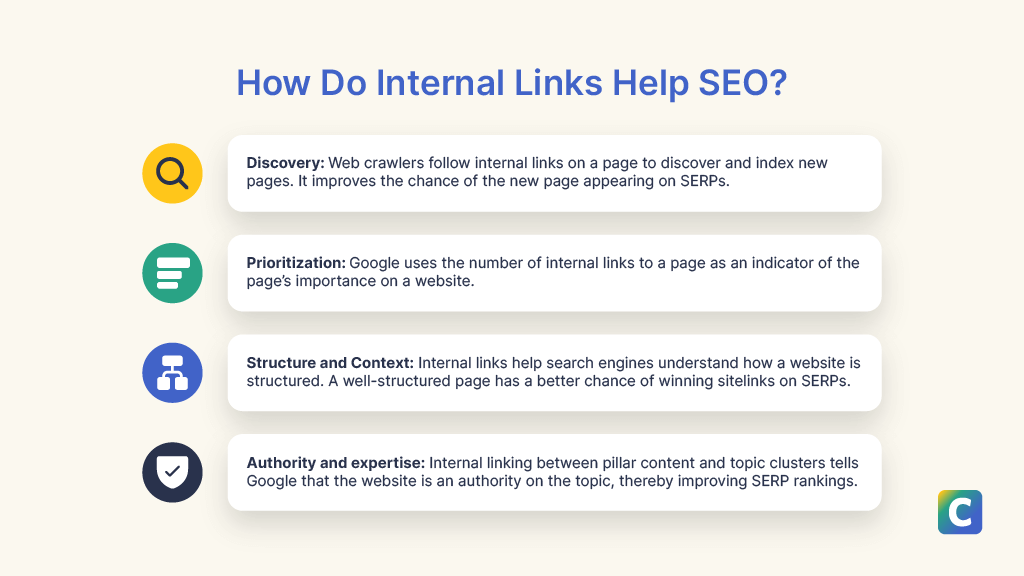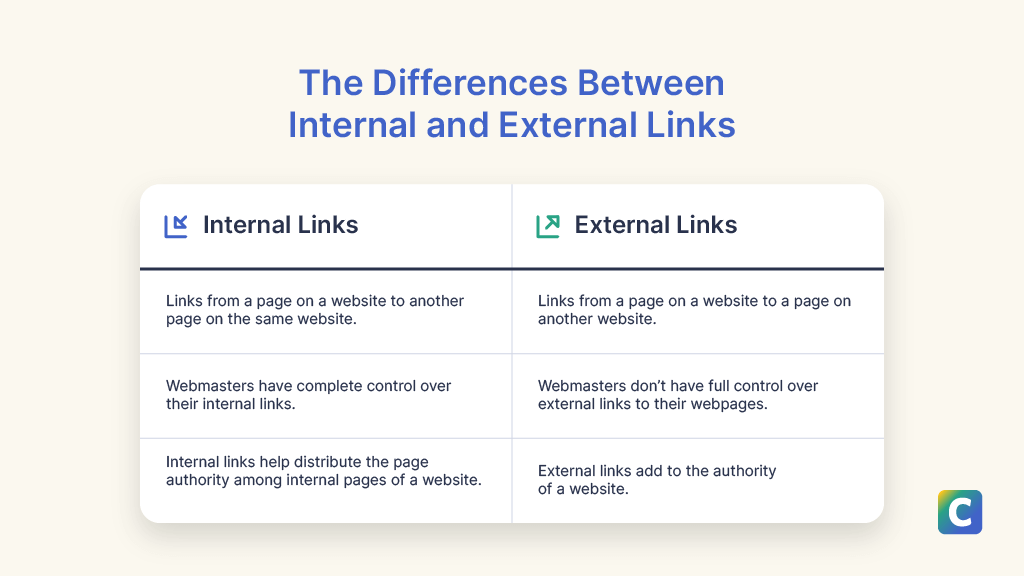Internal Linking: What It Is and Why It Matters for SEO
Topic: Link Building
Published:
Written by: Bernard Huang
TL;DR: What Is Internal Linking?
Internal linking refers to the practice of linking one page on a website to another page within the same site. This technique is a fundamental part of site structure and Search Engine Optimization (SEO).
Unlike external links, which point to pages on different websites, internal links keep users within the same domain.
For instance, if you're reading a blog post and click a link that directs you to another article on the same site, that's an internal link.
This practice helps search engine crawlers understand the site structure and discover new content efficiently.
Quick Overview of Internal Linking
The key distinction between internal and external links lies in their target locations.
Internal links connect pages within your website, while external links lead the user or bots to different domains.
Both types play vital roles in SEO, but internal links are crucial for optimizing website navigation and user experience.
Internal links also assist in link building by distributing link value across the site, enhancing the overall authority.
Key Terms Explained
Anchor Text: This is the clickable text in a hyperlink, which should describe the linked page's content. For example, "SEO tips" might be anchor text linking to a page about SEO strategies.
Link Juice: This is a colloquial term referring to the value or authority passed from one page to another via links, closely related to link value.
Link Equity: This is the SEO value passed from one webpage to another, influencing search engine rankings.
Crawlability: This term refers to how easily a search engine can crawl or access the pages of a website, enhanced by a well-organized internal linking structure. Bots from search engines follow these internal links to index content.

Why Internal Linking Matters for SEO
Understanding internal linking is crucial for SEO beginners.
It's one of the simplest yet most impactful ways to improve a website's SEO performance.
Proper internal linking helps search engines understand the relationship between different pages and their relative importance, which can directly affect search rankings.
Additionally, internal linking best practices help direct users to relevant content, enhancing their overall experience.
The benefits include:
Enhancing your SEO
Improving UX and site navigation
Boosting page authority
1. It Enhances Search Engine Optimization
Internal linking is essential for SEO because it helps distribute link value across a website, enhancing the SEO of important pages—and not just your homepage. It’s a smart way to boost important pieces of content across your site, too.
Search engines like Google use internal links to discover new pages, determine the hierarchy of website pages, and distribute authority.
The number of internal links pointing to a page can signal its importance within the site structure.
2. It Improves User Experience and Navigation
Internal links significantly enhance user experience by simplifying website navigation.
Effective internal linking helps users find relevant content, keeping them engaged and reducing bounce rates.
For example, the main navigation menu, navigation menu, footer links, and category pages guide users to the most important pages or essential areas of your site.
3. It Boosts Page Authority and Ranking Factors
Internal linking helps establish a page's authority within a website.
Pages with more internal links are often considered more important, which can boost their authority and influence PageRank—a Google algorithm component that assesses the importance of web pages.
High-authority pages can pass this value to other pages, supporting the site's overall SEO strategy.
How Do Internal Links Work?
Internal Linking Structure and Site Architecture
A well-planned internal linking structure is fundamental to a robust website structure.
There are different types of internal links, including:
Contextual Links: Links within the body content that guide users to related pages or internal pages. For instance, a piece of content about SEO might link to another article on keyword research.
Navigational Links: Links that are part of the site's navigation, such as menus, subcategories, or sidebars.

Implementing Internal Links
Internal links can be placed in various locations, such as headers, footers, or sidebars.
Tools like Clearscope’s Content Inventory, Ahrefs, SEMrush, or the Yoast SEO plugin for WordPress can help identify internal linking opportunities and optimize for them.
These tools often provide suggestions for internal links based on the content and SEO goals, such as linking landing pages and target pages.
Internal Linking Strategy
Building a strategic internal linking approach involves identifying key pages that need more visibility throughout your site or in the search engine results pages (SERPs) and ensuring they are linked appropriately.
It's essential to use descriptive anchor text and avoid over-optimization, like keyword stuffing.
Pro-tip: Overusing internal links or using irrelevant anchor text can lead to penalties from search engines.
Here’s an example of paying attention to the importance of internal linking in your content strategy:
Suppose you have Pages A, B, C, and D, all covering related topics about your business’s services. However, Page D isn’t linked internally from the content on Pages A, B, or C.
Page D would be considered an orphan, and it would be a piece of content that will take more effort for both interested readers and search bots to find.
Best Practices for Internal Linking
1. Create a Robust Internal Linking Strategy
Linking to high-quality and relevant pages is crucial for maintaining link value and ensuring a seamless user journey.
When developing an internal linking strategy, focus on creating links that enhance user experience and not just SEO.
Use descriptive anchor text to give users and search engines clear signals about the linked page's content and match the intent of related search queries.
2. Avoid Common Pitfalls
Common issues like broken links, orphan pages (pages with no incoming internal links), and improper redirects can harm SEO.
It's also important to understand the use of nofollow tags, which instruct search engines not to pass link equity.
While nofollow links can be useful in certain contexts, overuse can hinder your optimization efforts.
Ensuring text links are clear and well-placed is also vital for usability.
3. Monitor and Measure Results
Regularly monitoring your internal linking structure using tools like Clearscope, Google Search Console, or Screaming Frog is crucial.
These tools help identify issues like broken links and provide insights into metrics such as crawl depth, while Google Analytics can help you identify issues with engagement or bounce rates.
This data can guide adjustments to your internal linking strategy to improve SEO performance.
Additional Considerations for Internal Linking
Internal Linking in Different Contexts
Internal linking strategies can vary depending on the type of website.
For instance, ecommerce sites might focus on linking product pages and categories, while blogs might emphasize content marketing and related articles.
Regardless of the context, effective internal linking supports broader digital marketing and SEO strategies.
The Role of Internal Links in SEO Tools
Tools like Clearscope, SEMrush, or Ahrefs offer features that help spot internal linking opportunities.
Unlike traditional SEO tools, Clearscope specifically can help you easily identify valuable pages in your Content Inventory that need more internal links.
SEO case studies often highlight how strategic internal linking, including offering breadcrumbs and follow links, can improve a site's SEO performance.
Common Questions About Internal Linking
What are backlinks?
Backlinks are external links from one website to another. They differ from internal links, which are within the same website.
What is the difference between internal and external linking?
Internal linking connects different pages within the same website, while external linking connects pages across different websites.

Differences between internal and external links.
What do we mean by descriptive anchor text?
Descriptive anchor text clearly describes the content of the linked page, helping both users and search engines understand the link's context.
How do you build an internal linking strategy for SEO?
To build an internal linking strategy, start by identifying key pages and content that need more visibility.
Use descriptive anchor text and place links in strategic locations. Regularly audit and update the internal linking structure to ensure optimal SEO performance.
Additional Resources and Citations
For more detailed information on internal linking and SEO strategies, check out these resources:
12 Proven Internal Linking Best Practices and Strategies to Boost SEO Performance
Discover internal linking best practices that boost your SEO rankings. Learn strategies for passing link equity, fixing broken links, and creating a powerful topic cluster structure.
Read more5 Effective Internal Linking Strategies to Improve Your SEO
Advance your internal linking efforts by exploring several effective strategies that can help improve user experience, engagement, and SEO performance.
Read moreHow To Find Broken Links on Your Website and Fix Them
Discover the best tools to help you monitor broken links on your website and fix them to improve your SEO rankings and overall online user experience.
Read more